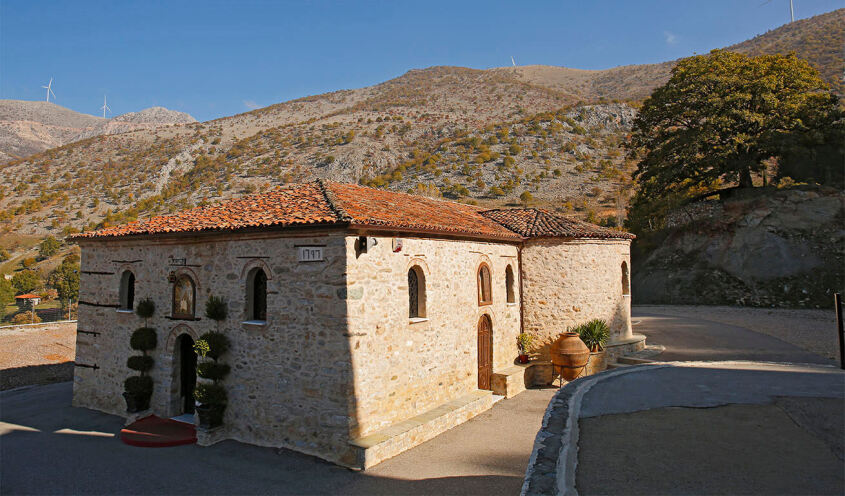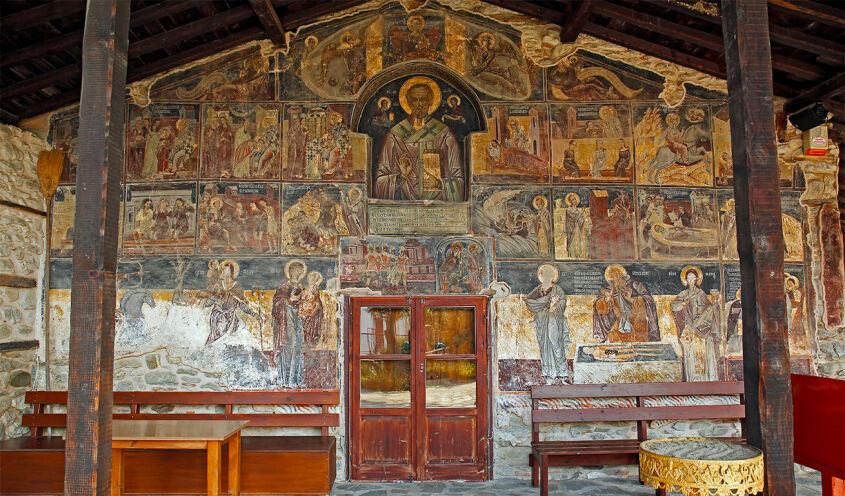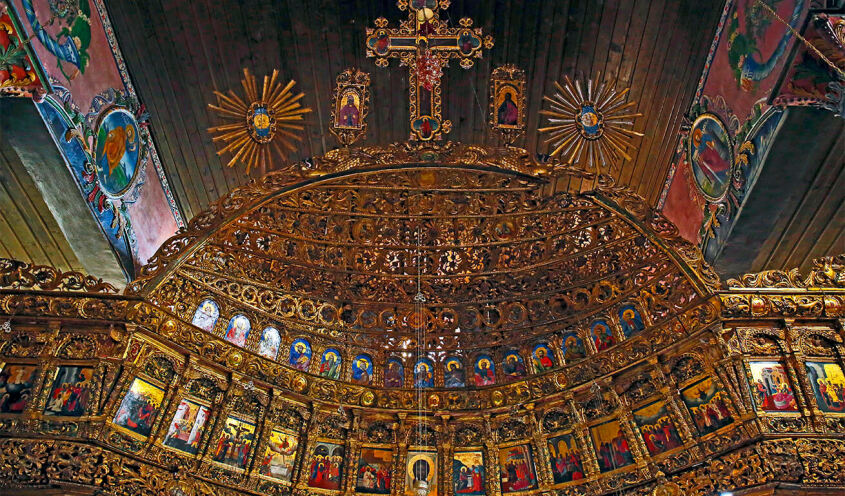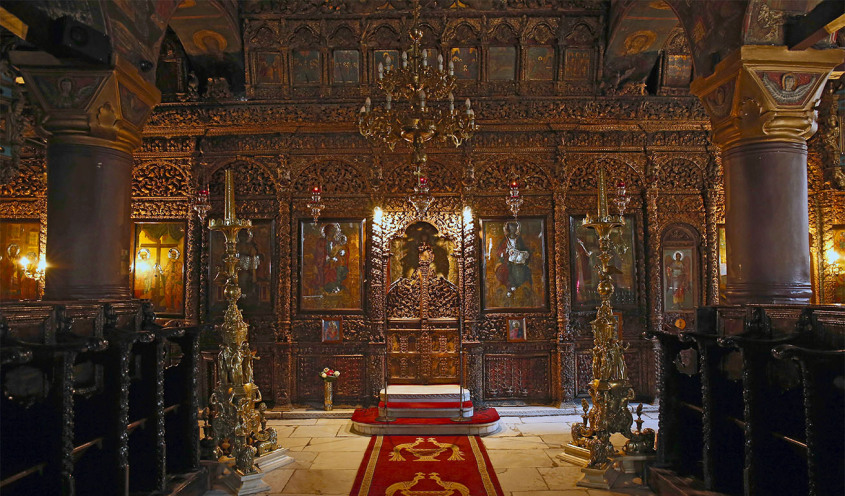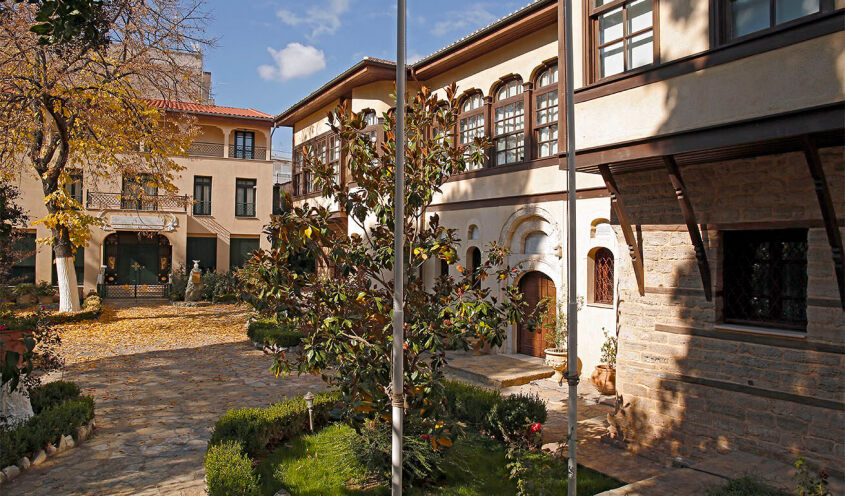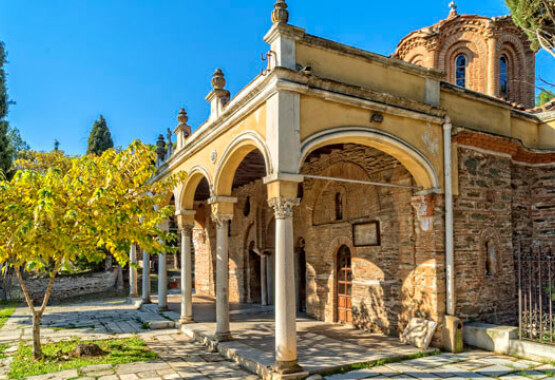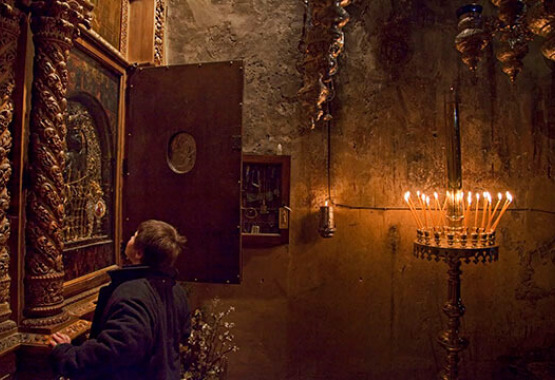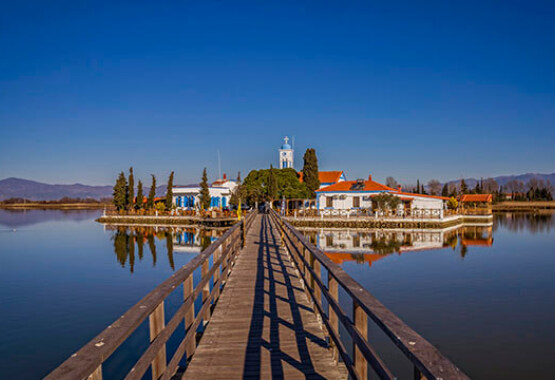
KOZANI
The Monastery of the Holy Trinity has stood in the same location since 1792, in a magnificent landscape covered in chestnut and beech trees, between the villages of Vythos and Avgerinos. The monastery katholikon (main church) follows the style of Mt. Athos churches. It was built with hewn stones by the master builder G. Koustas from Zoupani (Pentalofos) and the impressive religious paintings were crafted by folk painter Michael from Chioniades, Konitsa. The murals in the Church of Agios Achilleios, at the entrance of Pentalofos, were created in the same style by the same hand, according to the founding inscription in 1742. The church was built by local craftsmen and is the oldest of four in the village. The depictions in the church’s matroneum [women’s section] are exceptional. The church of the patron saint Agios Athanasios, in Pentalofos’ central square, was built in 1816 and is the second oldest in the area.
The Monastery of the Dormition of the Virgin was built in the early 19th century, near the village of Mikrokastro. Initially it was a church, but gradually developed into a monastery, which has been active in national struggles and charity. Its katholikon is adorned with Byzantine Art murals.The monastery is connected with the custom of the Siatista Kavalarides.
Agia Paraskevi Church in Siatista is a great example of post-Byzantine architecture. Built in 1677, in the shape of a domed three-aisled basilica with exquisite icons and a carved iconostasis (icon screen), it dominates the central square of Geraneia district, together with its high hexagonal bell tower, which was added in 1862. Agios Dimitrios church in Chora is impressive in size and architectural design. It was built in 1912, in the other district of Siatista, according to the plans of the local architect Aristotelis Zachos, on the site of an older church, which was destroyed by fire. Its 25-metre-high bell tower, a town landmark, was built in 1856, and is similar to that of Agia Paraskevi church.
Agios Athanasios Monastery was built circa 1600 on the slope of Mt. Siniatsiko, just two kilometres higher than Eratyra. The katholikon took on its current form after the monastery was rebuilt in the wake of a disaster that happened in the late 18th century. The neighbouring buildings of the monastery are much newer. The katholikon’s wood-carved icon screen is very impressive. Agios Georgios church with its towering belfry in the centre of Eratyra was built before the mid-19th-century, probably by local craftsmen, in the style of a five-aisled basilica, with the fifth aisle as an exonarthex. Visitors are impressed by the wood-carved gilded icon screen and the church’s rich interior decoration, which is the work of religious painters of the Selitsa “school”, the former name of Eratyra. Just off the town limits, the small church of Agios Nikolaos may look plain on the outside, but it has some remarkable murals inside, which are the work of a local monk; they are considered to be among the best examples of post-Byzantine art in the area.
Agia Paraskevi Monastery was built on a Mt. Siniatsiko slope, near Namata village, and it was most likely founded in the 14th century. It was destroyed many times during the period of the Ottoman rule and during the German occupation. The katholikon, which was probably rebuilt in the 16th century, is the only building to have survived and contains icons of exceptional artistry. The remaining buildings were constructed after the re-establishment of the monastery in 2001.
Orthodox trails in Kozani
In every village or town in Kozani, there is a centuries-old church or monastery, which recounts stories of piety and art through its masonry, its wonderful murals and carved icon screens. These are the works of stone craftsmen, folk painters and wood carvers, which reflect the conditions that prevailed in each area at the time of their construction. Churches, for example, were built without a dome or almost at ground level, in line with the orders of the Ottoman conquerors.The Monastery of the Holy Trinity has stood in the same location since 1792, in a magnificent landscape covered in chestnut and beech trees, between the villages of Vythos and Avgerinos. The monastery katholikon (main church) follows the style of Mt. Athos churches. It was built with hewn stones by the master builder G. Koustas from Zoupani (Pentalofos) and the impressive religious paintings were crafted by folk painter Michael from Chioniades, Konitsa. The murals in the Church of Agios Achilleios, at the entrance of Pentalofos, were created in the same style by the same hand, according to the founding inscription in 1742. The church was built by local craftsmen and is the oldest of four in the village. The depictions in the church’s matroneum [women’s section] are exceptional. The church of the patron saint Agios Athanasios, in Pentalofos’ central square, was built in 1816 and is the second oldest in the area.
The Monastery of the Dormition of the Virgin was built in the early 19th century, near the village of Mikrokastro. Initially it was a church, but gradually developed into a monastery, which has been active in national struggles and charity. Its katholikon is adorned with Byzantine Art murals.The monastery is connected with the custom of the Siatista Kavalarides.
Agia Paraskevi Church in Siatista is a great example of post-Byzantine architecture. Built in 1677, in the shape of a domed three-aisled basilica with exquisite icons and a carved iconostasis (icon screen), it dominates the central square of Geraneia district, together with its high hexagonal bell tower, which was added in 1862. Agios Dimitrios church in Chora is impressive in size and architectural design. It was built in 1912, in the other district of Siatista, according to the plans of the local architect Aristotelis Zachos, on the site of an older church, which was destroyed by fire. Its 25-metre-high bell tower, a town landmark, was built in 1856, and is similar to that of Agia Paraskevi church.
Agios Athanasios Monastery was built circa 1600 on the slope of Mt. Siniatsiko, just two kilometres higher than Eratyra. The katholikon took on its current form after the monastery was rebuilt in the wake of a disaster that happened in the late 18th century. The neighbouring buildings of the monastery are much newer. The katholikon’s wood-carved icon screen is very impressive. Agios Georgios church with its towering belfry in the centre of Eratyra was built before the mid-19th-century, probably by local craftsmen, in the style of a five-aisled basilica, with the fifth aisle as an exonarthex. Visitors are impressed by the wood-carved gilded icon screen and the church’s rich interior decoration, which is the work of religious painters of the Selitsa “school”, the former name of Eratyra. Just off the town limits, the small church of Agios Nikolaos may look plain on the outside, but it has some remarkable murals inside, which are the work of a local monk; they are considered to be among the best examples of post-Byzantine art in the area.
Agia Paraskevi Monastery was built on a Mt. Siniatsiko slope, near Namata village, and it was most likely founded in the 14th century. It was destroyed many times during the period of the Ottoman rule and during the German occupation. The katholikon, which was probably rebuilt in the 16th century, is the only building to have survived and contains icons of exceptional artistry. The remaining buildings were constructed after the re-establishment of the monastery in 2001.
